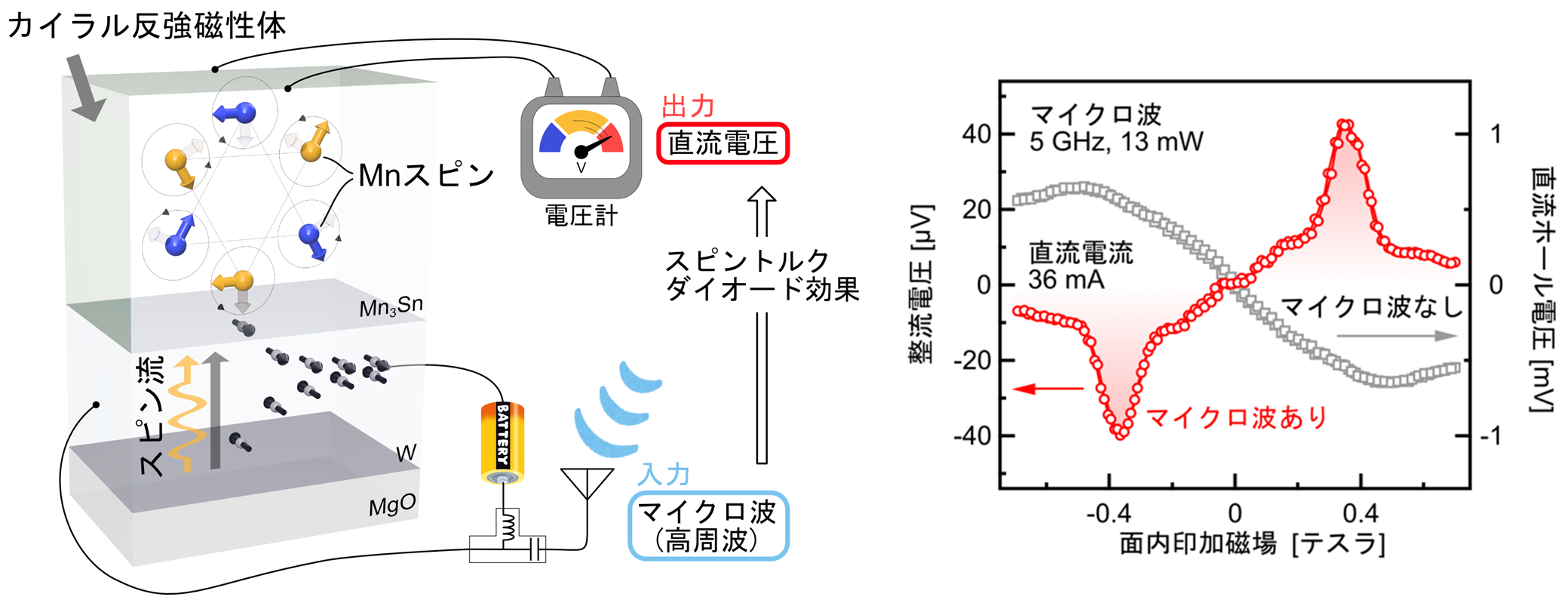DATE2024.12.03 #Press Releases
Stable even at high frequencies: Discovery of a novel spin torque diode effect
-Beyond 5G: New Prospects for Ultrafast Magnetic Devices-
Summary
Assistant Professor Shoya Sakamoto and Associate Professor Shinji Miwa of the Institute for Solid State Physics, The University of Tokyo, in collaboration with Graduate School of Science, Research Center for Advanced Science and Technology, Research Center for New Principles in Computing, National Institute of Advanced Industrial Science and Technology, and Japan Synchrotron Radiation Research Institute, have discovered the spin torque diode effect in a new material "chiral antiferromagnet," which is capable of stable operation at higher frequencies than the conventional material, ferromagnetic materials. The new material, "chiral antiferromagnet," exhibits a spin-torque diode effect that enables stable operation at higher frequencies than conventional ferromagnetic materials.
They thinned a manganese compound (Mn3Sn) with a special magnetic structure called a chiral antiferromagnet to the limit of less than 10 nanometers and discovered that a direct current voltage appears when a microwave current (high frequency current) is applied (Figure). The effect of an alternating current producing a DC voltage is widely known as the diode effect, and semiconductors are widely used in general society as rectifier diodes. In the spin torque diode effect, the spin pivoting motion corresponding to the rotation of electrons produces the rectifying effect, which is similar to the rectifying diode in semiconductors. Although there have been reports of spin torque diodes using ferromagnetic materials that exceed the detection sensitivity of microwave currents in semiconductor diodes, there is a problem that the signal (voltage) strength decreases inversely and rapidly as the frequency increases. In this research, by taking advantage of the characteristics of antiferromagnets, which have high energy exchange interactions, we have realized a diode effect that can maintain signal strength with 10-100 times greater stability than ferromagnets, even at high frequencies. The realization of this new spin-torque diode is expected to lead to the development of next-generation spintronics and high-speed communications.
These results were published online in Nature Nanotechnology, a British scientific journal, on December 3, 2024.
Professor Satoshi Nakatsuji and Project Associate Professor Tomoya Higo of the Department of Physics participated in this research.

Figure: Schematic diagram of the research (left) and the obtained rectified voltage signal (right).
Left: When DC and microwave currents are applied to a bilayer film of Mn3Sn alloy and W (tungsten), a lateral DC voltage appears in response to the microwave application. Right: Actual data. When microwaves are applied, a voltage signal with a characteristic peak structure proportional to the microwave power appears.
Links: Institute for Solid State Physics, The University of Tokyo, National Institute of Advanced Industrial Science and Technology (AIST), Japan Science and Technology Agency(in Japanese)
Journals
-
Journal name Nature NanotechnologyTitle of paper


